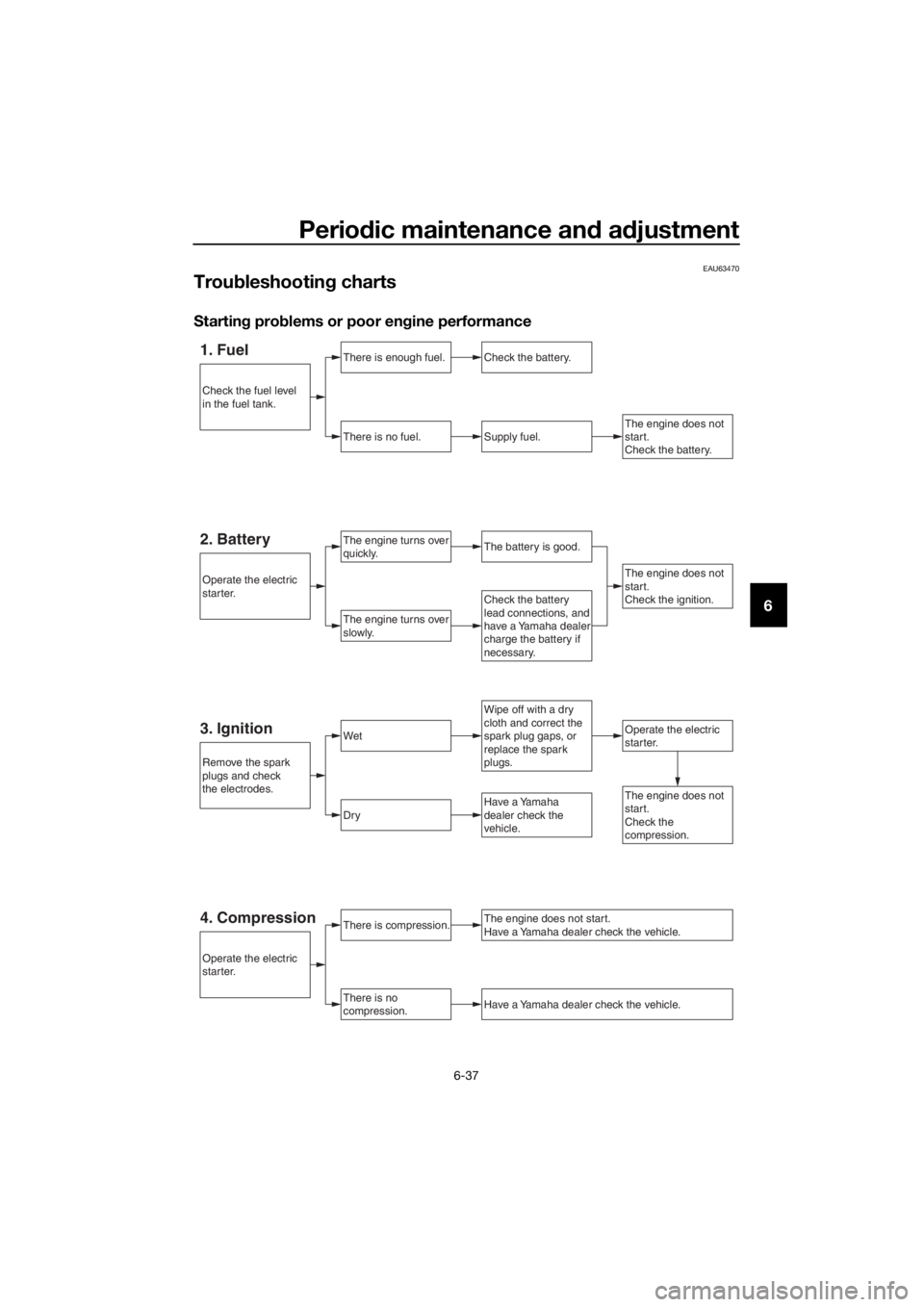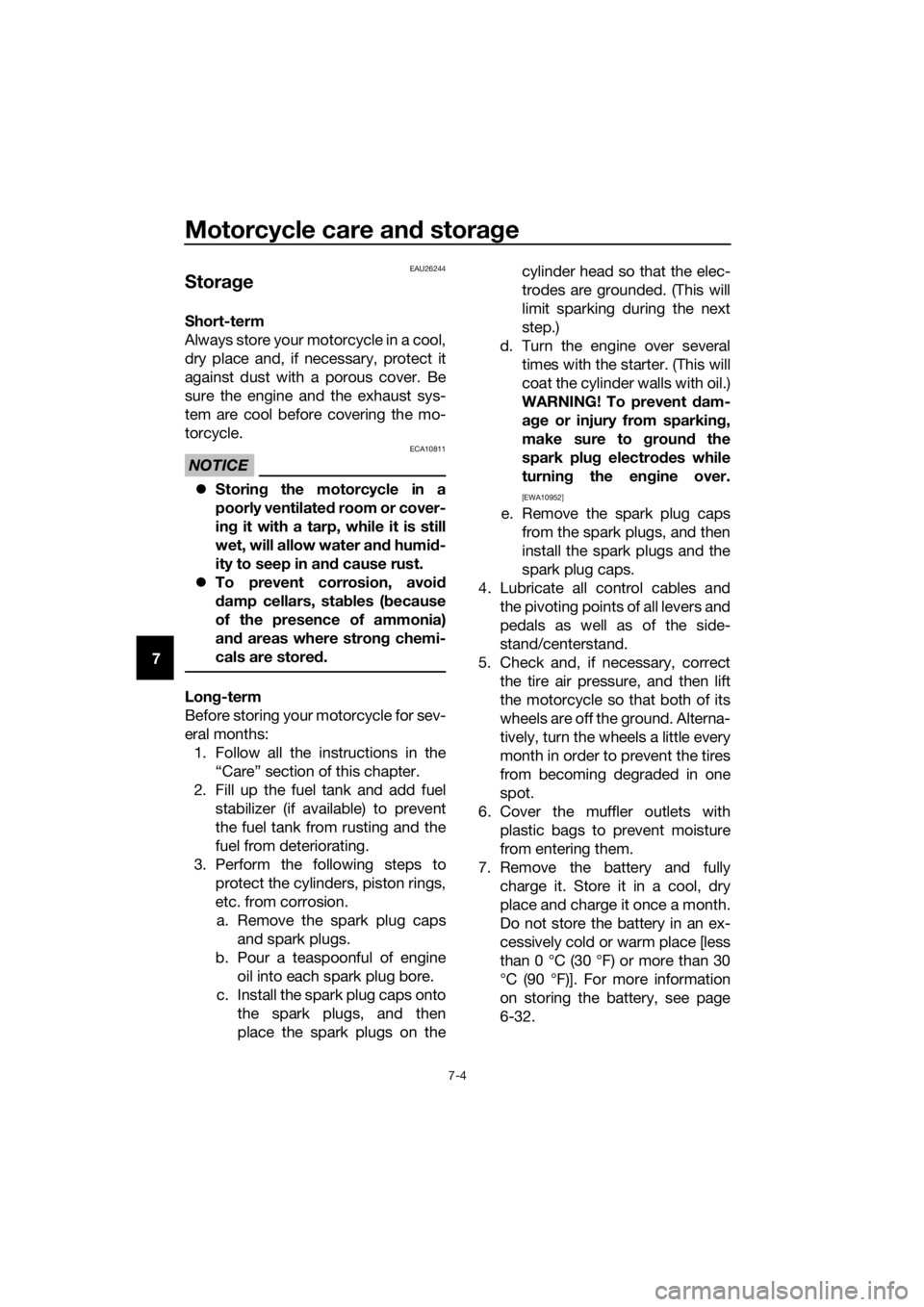check engine YAMAHA FJR1300A 2016 Owner's Manual
[x] Cancel search | Manufacturer: YAMAHA, Model Year: 2016, Model line: FJR1300A, Model: YAMAHA FJR1300A 2016Pages: 120, PDF Size: 3.41 MB
Page 105 of 120

Periodic maintenance an d a djustment
6-37
6
EAU63470
Trou bleshootin g charts
Startin g pro blems or poor en gine performance
1. FuelThere is enough fuel.
There is no fuel.
Check the battery.
Supply fuel.
The engine turns over
quickly.
The engine turns over
slowly.
The engine does not
start.
Check the battery.
Wipe off with a dry
cloth and correct the
spark plug gaps, or
replace the spark
plugs.
Check the battery
lead connections, and
have a Yamaha dealer
charge the battery if
necessary.
2. BatteryThe battery is good.
The engine does not
start.
Check the ignition.
3. IgnitionWetOperate the electric
starter.
Dry
There is compression.
There is no
compression.
The engine does not start.
Have a Yamaha dealer check the vehicle.
Have a Yamaha dealer check the vehicle.
The engine does not
start.
Check the
compression.Have a Yamaha
dealer check the
vehicle.
Remove the spark
plugs and check
the electrodes.
Operate the electric
starter.
Operate the electric
starter.
Check the fuel level
in the fuel tank.
4. Compression
UB88E0E0.book Page 37 Friday, October 16, 2015 11:59 AM
Page 106 of 120

Periodic maintenance an d a djustment
6-38
6 En
gine overheatin g
WARNING
EWAT1041
Do not remove the ra diator cap when the en gine an d ra diator are hot.
Scal din g hot flui d an d steam may b e blown out un der pressure, which
coul d cause serious injury. Be sure to wait until the eng ine has cooled.
Place a thick ra g, like a towel, over the ra diator cap, an d then slowly ro-
tate the cap counterclockwise to the detent to allow any resi dual pres-
sure to escape. When the hissin g soun d has stopped , press down on the
cap while turnin g it counterclockwise, an d then remove the cap.
TIP
If coolant is not available, tap water can be temporarily used instead, provided
that it is changed to the recommended coolant as soon as possible.
Wait until the engine
has cooled.
Check the coolant
level in the reservoir
and radiator.Add coolant.
(See TIP.)
The coolant level is
OK.
There is no leakage.
There is leakage.
The coolant level is
low.
Check the cooling
system for leakage.
Have a Yamaha
dealer check and
repair the cooling
system.
Start the engine. If the engine overheats again,
have a Yamaha dealer check and repair the cooling
system.
UB88E0E0.book Page 38 Friday, October 16, 2015 11:59 AM
Page 110 of 120

Motorcycle care and stora ge
7-4
7
EAU26244
Stora ge
Short-term
Always store your motorcycle in a cool,
dry place and, if necessary, protect it
against dust with a porous cover. Be
sure the engine and the exhaust sys-
tem are cool before covering the mo-
torcycle.
NOTICE
ECA10811
Storin g the motorcycle in a
poorly ventilated room or cover-
in g it with a tarp, while it is still
wet, will allow water an d humi d-
ity to seep in and cause rust.
To prevent corrosion, avoi d
d amp cellars, sta bles ( because
of the presence of ammonia)
an d areas where stron g chemi-
cals are stored .
Long-term
Before storing your motorcycle for sev-
eral months: 1. Follow all the instructions in the “Care” section of this chapter.
2. Fill up the fuel tank and add fuel stabilizer (if available) to prevent
the fuel tank from rusting and the
fuel from deteriorating.
3. Perform the following steps to protect the cylinders, piston rings,
etc. from corrosion.a. Remove the spark plug caps and spark plugs.
b. Pour a teaspoonful of engine oil into each spark plug bore.
c. Install the spark plug caps onto the spark plugs, and then
place the spark plugs on the cylinder head so that the elec-
trodes are grounded. (This will
limit sparking during the next
step.)
d. Turn the engine over several times with the starter. (This will
coat the cylinder walls with oil.)
WARNING! To prevent d am-
a g e or injury from sparkin g,
make sure to groun d the
spark plu g electro des while
turnin g the en gine over.
[EWA10952]
e. Remove the spark plug caps
from the spark plugs, and then
install the spark plugs and the
spark plug caps.
4. Lubricate all control cables and the pivoting points of all levers and
pedals as well as of the side-
stand/centerstand.
5. Check and, if necessary, correct the tire air pressure, and then lift
the motorcycle so that both of its
wheels are off the ground. Alterna-
tively, turn the wheels a little every
month in order to prevent the tires
from becoming degraded in one
spot.
6. Cover the muffler outlets with plastic bags to prevent moisture
from entering them.
7. Remove the battery and fully charge it. Store it in a cool, dry
place and charge it once a month.
Do not store the battery in an ex-
cessively cold or warm place [less
than 0 °C (30 °F) or more than 30
°C (90 °F)]. For more information
on storing the battery, see page
6-32.
UB88E0E0.book Page 4 Friday, October 16, 2015 11:59 AM
Page 117 of 120

10-1
10
Index
A
ABS ...................................................... 3-26
ABS warning light ................................... 3-5
Accessory box...................................... 3-36
Air filter element, cleaning .................... 6-17
Auxiliary DC jack .................................. 3-46
B
Battery .................................................. 6-32
Brake and clutch fluid levels,
checking............................................. 6-25
Brake and clutch fluids, changing ........ 6-27
Brake and clutch levers, checking
and lubricating ................................... 6-29
Brake and shift pedals, checking and
lubricating .......................................... 6-28
Brake lever ........................................... 3-25
Brake lever free play, checking ............ 6-23
Brake light switches ............................. 6-24
Brake pedal .......................................... 3-25
C
Cables, checking and lubricating ......... 6-27
Canister ................................................ 6-11
Care ........................................................ 7-1
Catalytic converters ............................. 3-31
Centerstand and sidestand, checking
and lubricating ................................... 6-29
Clutch lever ................................. 3-24, 6-23
Coolant ................................................. 6-15
Cowling vents, opening and closing .... 3-38
Cruise control indicator lights ................ 3-4
Cruise control switches ........................ 3-23
Cruise control system ............................ 3-7
D
Diagnostic connector ............................. 9-2
Dimmer/Pass switch ............................ 3-22
D-mode (drive mode) ........................... 3-22
E
Engine break-in ...................................... 5-5
Engine idling speed, checking ............. 6-18
Engine oil and oil filter cartridge ........... 6-11
Engine serial number.............................. 9-1
Engine trouble warning light................... 3-5
F
Final gear oil ......................................... 6-14
Front and rear brake pads, checking ... 6-24
Front fork, adjusting ............................. 3-40
Front fork, checking ............................. 6-31
Fuel....................................................... 3-29
Fuel consumption, tips for reducing ...... 5-4
Fuel tank cap........................................ 3-28 Fuel tank overflow hose ........................ 3-30
Fuses, replacing.................................... 6-34
H
Handlebar position, adjusting ............... 3-37
Handlebar switches .............................. 3-22
Hazard switch ....................................... 3-23
Headlight beams, adjusting .................. 3-37
High beam indicator light........................ 3-4
Horn switch........................................... 3-23
I
Identification numbers ............................ 9-1
Ignition circuit cut-off system ............... 3-44
Immobilizer system ................................. 3-1
Immobilizer system indicator light .......... 3-6
Indicator lights and warning lights .......... 3-4
M
Main switch/steering lock ....................... 3-2
Maintenance and lubrication, periodic ... 6-4
Maintenance, emission control
system .................................................. 6-3
Matte color, caution ................................ 7-1
Menu switch ......................................... 3-23
Model label ............................................. 9-1
Multi-function meter unit ...................... 3-10
N
Neutral indicator light.............................. 3-4
O
Oil level warning light .............................. 3-4
P
Panels, removing and installing .............. 6-7
Parking .................................................... 5-6
Part locations .......................................... 2-1
R
Rear suspension, lubricating ................ 6-30
Rear view mirrors .................................. 3-39
Rider seat height, adjusting .................. 3-33
S
Safety information................................... 1-1
Seats ..................................................... 3-31
Select switch ........................................ 3-23
Shifting .................................................... 5-3
Shift pedal............................................. 3-24
Shock absorber assembly, adjusting ... 3-42
Sidestand .............................................. 3-43
Spark plugs, checking .......................... 6-10
Specifications ......................................... 8-1
Starting the engine.................................. 5-2
Steering, checking ................................ 6-31
Stop/Run/Start switch .......................... 3-23
Storage ................................................... 7-4
UB88E0E0.book Page 1 Friday, October 16, 2015 11:59 AM